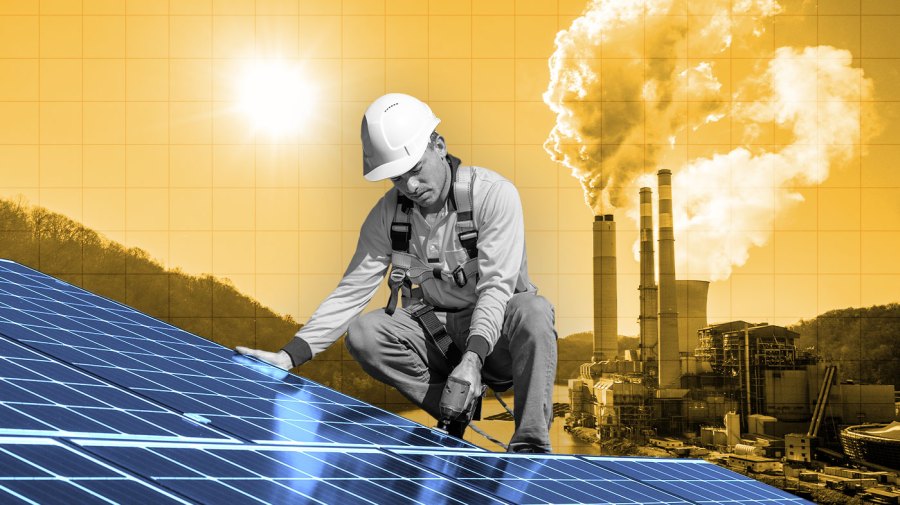
The U.S. is barreling toward an energy transition as renewables — especially solar — become ever-cheaper sources of energy.
Renewables and natural gas have been gaining while coal has declined for years, but the trends have accelerated since the Inflation Reduction Act (IRA), Democrats’ climate, tax and health care bill, passed in 2022 with massive subsidies for renewables.
In 2023, renewables accounted for more than 20 percent of the electricity generated in the U.S., roughly double their 2010 share, according to the Energy Information Administration. Natural gas, meanwhile, contributed about 43 percent, up from 24 percent in 2010.
And both solar and gas power are expected to grow more in the years ahead.
“The power sector is, year on year, adding a lot more renewables, and in particular solar. Solar is getting cheaper and its adoption is scaling,” said Thomas Rowlands-Rees, head of North America Research at BloombergNEF.
Massachusetts Institute of Technology (MIT) Professor Christopher Knittel agreed that the low cost of solar will be “driving a lot of adoption, because it’s just a cheap source of electricity.”
The unsubsidized cost of solar power dropped almost 85 percent between 2010 and 2023, according to the Environmental Protection Agency. Solar’s economics are now being bolstered by the IRA, whose generous tax credits for low-carbon power sources are being eyed for potential cuts by Republicans.
Some GOP lawmakers have pushed to retain at least some of the credits, however, and it’s not clear whether Republicans will be able to get the intra-party consensus they need to make such cuts — or which power sources, if any, will ultimately be impacted.
But even if those credits are repealed or shortened, Rowlands-Rees says solar power is here to stay.
Without the IRA, he said “build is less than it would have been, because obviously there’s not an incentive to support it, but it is not as impacted as you might think.”
“What the tax credits are doing is giving you 2030 economics in 2027, it’s just bringing forward when the technology is economically viable.”
Xizhou Zhou, Head of Power and Renewables for Wood Mackenzie, said that demand for both solar and gas are growing because demand for power at large is going up as data centers demand more electricity.
And electric power demand is only slated to grow in the years ahead, especially with the growth of artificial intelligence. Goldman Sachs has predicted that the amount of power needed to fuel data centers will increase 50 percent between 2023 and 2027, and will grow by 165 percent compared to 2023 by 2030.
President Trump has vowed to boost oil and gas production, and made moves to do so in his initial executive actions.
At least one expert, Knittel, says coal, rather than renewables, will be the casualty of that agenda, however.
“Over the next four years, I actually expect the reduction in coal generation to speed up because of President Trump’s victory,” he said.
“What he’s going to effectively do is provide us with a lot of cheap natural gas, and the closest substitute for natural gas is coal generation,” Knittel added.
Zhou noted that some of the gas that’s coming online may only run temporarily, in times when the sun isn’t shining, for example. Given that, and the slated coal plants retirements, so overall, he expects some progress on climate change.
“Your emissions trajectory is still on a downward trend,” he said.
Most of the world’s nations pledged to speed the transition from fossil fuels to renewable energy sources in the landmark Paris Climate Agreement, which set a goal of limiting global warming to 2.7 degrees Fahrenheit above preindustrial levels as part of an effort to evade some of the worst consequences of climate change. Trump issued an executive order on his first day in office directing the U.S. to withdraw from the agreement.
Nevertheless, Zhou said the ongoing shift will reduce emissions — but said it may not be enough to meet the global agreement’s goals.
“Is it sufficient to meet any of these Paris goals? The answer is no,” he said. But, he added, “the U.S. can still go to a climate conference and say ‘my emissions are going down. It’s just not as fast as 1.5 degrees [Celsius] demands.”
As the energy mix moves away from coal and in the direction of renewables, that may also change the landscape of where and for whom jobs are available.
In a primarily fossil-fueled economy, energy jobs were very concentrated in the oil patch and the coal mine. However, since solar and wind plants can be built in a variety of places — as farms on large swaths of land, on a small scale on peoples’ homes and businesses and, in wind’s case, even offshore — jobs may be more distributed.
“A lot of additional jobs from wind and solar would be in the actual getting the stuff built on the ground, whereas with less consumption of gas and coal, there would be fewer jobs in fuel extraction,” said Rowlands-Rees.












